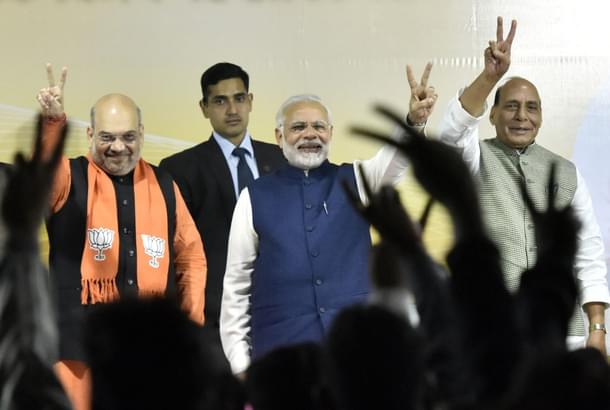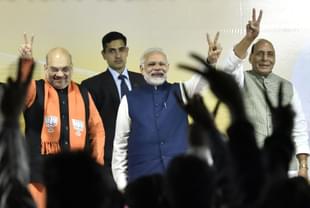Politics
Decoding The Gujarat Verdict: Voters Gave BJP A ‘Jhatka’, Not A ‘Thappad’
R Jagannathan
Dec 19, 2017, 02:57 PM | Updated 02:57 PM IST
Save & read from anywhere!
Bookmark stories for easy access on any device or the Swarajya app.


The overall outcome of the Gujarat assembly polls can be explained by simply looking at how the voter dealt with the one dilemma he was trying to resolve: how to teach the Bharatiya Janata Party (BJP) a lesson for failing to address their core concerns without making their favourite son, Narendra Modi, pay the price for this anger. This is what explains the 99-seat victory of the party. The voter delivered a sharp rap on the knuckles, but saved Modi the blushes. Voters wanted to give BJP a ‘jhatka’ (jolt), not a ‘thappad’ (slap).
The party’s variable show across the four regions – Saurashtra-Kutch, north Gujarat, central Gujarat and south Gujarat – is representative of the intensity of the pain felt across regions, with those feeling more pain inflicting a larger rap than those who felt less of it.
Broadly speaking, the BJP came close to losing the election in Saurashtra-Kutch, but contained the damage in the other three regions, where it either lost fewer seats (one and three in north and south Gujarat), or none (in central Gujarat). The damage was done entirely in Saurashtra-Kutch, where it lost 12 seats. The damage was done almost wholly in rural constituencies, and very little in urban ones.
But there is one more quirk at work in highly urbanised Gujarat, as several analysts have noted repeatedly: the BJP’s vote is concentrated in urban areas, while the Congress vote is evenly distributed across the regions of the state.
This is why a party that actually improved its vote share from 47.9 per cent in 2012 to 49.1 per cent in 2017 ended up getting 16 fewer seats. This is why a party that had a near eight percentage point vote advantage over its rival (Congress got 41.4 per cent) lost seats while the latter gained. Where the BJP won in urban areas, it won with large margins; where it lost, it lost narrowly.
(To get the two best analyses of what happened in Gujarat, you can do no better than to read Aashish Chandorkar’s article here, and this Times of India piece on why the BJP lost seats while getting even more votes in a two-horse race. There are many more good insights, and I will refer to them later in this overview).
As the Times article suggests, in the 33 urban seats the BJP won, its average margin of victory was a huge 47,000; in the mixed urban-rural constituencies, the BJP’s average margin was a still high 26,000 votes. This is the classic Hillary Clinton problem, where a huge advantage in popular votes in California and New York did not give her the presidency. She got a much larger share of the vote than Donald Trump, but the latter got a larger share of votes in the electoral college, which is what counts in the US constitution. Trump won by winning in states that had more electoral votes than voters.
The BJP’s sharp drop in seats is the result of the greater weightage given to rural votes in India’s skewed delimitation of constituencies which is rural-biased. A shift in the delimitation will give the BJP a permanent lock on power in Gujarat. An eight-percentage vote advantage normally yields a sweep in a first-past-the-post system, especially in a two-party race.
The fact that the NOTA option in the EVM button (none of the above) scored 1.8 per cent (the third highest vote share after BJP and Congress) also shows how the voter protested against the BJP without humiliating Modi. In any normal anti-incumbency vote, the anger against the ruling party benefits the party that is most likely to beat it. Not so in Gujarat, where many voters, despite their anger, could not bring themselves to vote for the Congress. It is further evidenced by another outcome of the elections: all the major Congress leaders – Shaktisinh Gohil, Arjun Modhvadia and Siddharth Patel (son of former CM Chimanbhai Patel) – lost the elections, while the BJP’s two main faces, Chief Minister Vijay Rupani and Deputy CM Nitin Patel, who should have been the targets of voter ire, both winning.
A small myth that needs partial busting is the belief that the Patidars caused most of the damage, thanks to the unrelenting campaign of its 20-something chief Hardik Patel. This is both true and not quite true. At the end of the day, the BJP won more Patidar-dominated seats (28 out of 52) than the Congress (Patidar seats are defined as those with a community concentration of more than 20 per cent). Not only that, but fewer Patidars got elected this time, down from 47 in 2012 to 44 this time. The switch in Patidar loyalties – as orchestrated by Hardik Patel – has ended up damaging Patidar solidarity, and also forced other castes to consolidate against them. It is interesting that the only bad-loser comment on alleged EVM hacking was from Hardik, when this was the first elections to have 100 per cent cross-checking with VVPATs (voter verified paper audit trails). Gujarat’s Chief Electoral Officer B B Swain confirmed that VVPATs showed no discrepancy in any polling booth when juxtaposed with EVM results.
The Patidars handed a defeat to the BJP in Saurashtra-Kutch, but stood by the party in all the urban seats. What this suggests is that the Patidar angst in the areas that voted against BJP had less to do with the caste-reservation issues raised by Hardik Patel, and more with agrarian issues, which were dominant in Saurashtra-Kutch. The fact that the BJP swept Surat (an urban Patidar bastion and epicentre of the anti-GST protests), and won even in Mehsana suggests that there is a class divide among Patidars too: the urban ones, more open to Hindutva enticements and often much better off, did not feel the need to ditch the BJP on grounds of rural distress or jobs for rural youth.
Of course, the BJP acted quickly in November to put out the growing anger over GST compliance, but this only shows that the party is more responsive to urban issues than rural issues – and benefited from it.
The Gujarat election, though it clearly shows a reviving Congress, hides a real problem for the party in future. If young leaders like Alpesh Thakor, Jignesh Mewani and Hardik Patel are going to gain traction, will it come at the cost of the Congress itself? It is no secret that the rise of Arvind Kejriwal, who broadly occupies the Congress secular space, has damaged the Congress more than the BJP, with its latent Hindutva appeal. So, the question Rahul Gandhi has to wrestle with is whether the newly-empowered firebrands in Gujarat will damage him or the BJP.
A larger issue that emerges from the election outcome is this: the BJP’s future lies in formally remodelling itself as an urban party, focused on urban issues. It needs to throw safety nets to rural areas, which surely need to be uplifted and helped to make the transition from subsistence farming to urban and semi-urban vocations, but this upliftment cannot come from farm loan waivers, higher minimum support prices (MSPs) or endless subsidies on fertiliser, diesel, power, seeds, and what-have-you. It has to come by focusing on building urban infrastructure, enhancing the devolution of power to urban areas and creating an enabling environment for jobs by reforming factor markets in land and labour.
To repeat: the solution to the agrarian crisis lies in creating an enabling environment for urban jobs and consolidating farms into more viable entities, which will, in turn, enable investments to raise farm productivity, incomes and jobs in the farms-to-fork supply chain, in rural logistics and cold chains and in vibrant markets for agri-produce. Farmers need a pathway out of agriculture, not a sop to remain there and wallow in poverty. It is far better to abandon MSPs and give the money as income support to farmers than to perpetuate a market-distorting agricultural policy regime that keeps farmers stuck in a low-productivity-low-output-low-income vicious circle.
While these are not ideas that emanate purely from the Gujarat results, the chances are the BJP’s poor performance in rural areas will prompt the party to make farm subsidies and sops the focus of its next budget. Farms do need support, but not of the kind that is now being perpetuated. Farms need investment, consolidation and productivity, not subsidies and waivers.
One hopes the BJP learns the right lessons from the Prime Minister’s home state, and not the wrong ones.
But Gujarat has sent the right message: don’t ignore the voter. A strong preference for one party can change if it starts taking voters for granted. They want Modi’s governance, not his party’s indifference to their concerns.
Jagannathan is former Editorial Director, Swarajya. He tweets at @TheJaggi.





